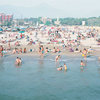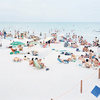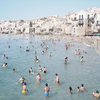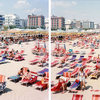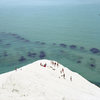A Conversation with Massimo Vitali
MORE IMAGES
“My photography comes from absolute matter-of-fact situations but also from a deep curiosity that I possess for people, for what they do and how they think.” - Massimo Vitali
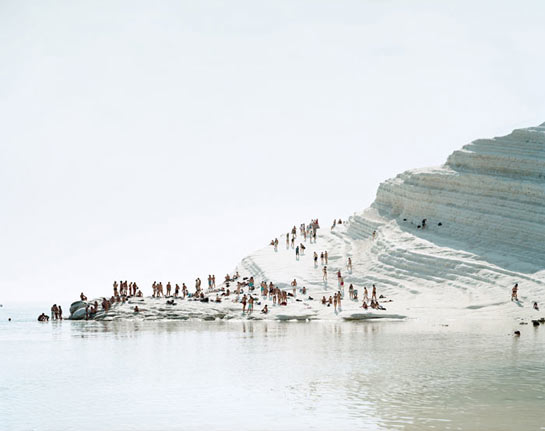
Massimo Vitali is one of the photographer who had been on top of my list to talk to for a while. I finally approached Massimo, and much to my delight he found the time to have a conversation about his work and his influences.
Jörg Colberg: Your large-scale photographs of crowded beaches, often taken with the camera pointed towards the land (so that there are blocks of buildings or even power stations in the background), and of crowded, popular tourist destinations give a dystopian view of mass tourism and of what - in principle - should be extremely enjoyable: taking time off to relax. How did you develop the idea for the series?
Massimo Vatali: While I was having lunch at restaurant La Pesa in Milan somebody stole my 4 x 5 equipment from my car, just leaving me with my heavy, bulky 8 x 10 camera. As everyone who deals with photography knows, taking photos with an 8 x 10 is a hard job, as the focusing can only be made tilting the front panel from an appropriate point of view. This led me to build a kind of oversized tripod with a friend of mine, that, by sheer coincidence, happened to be ready in the middle of summer, not long after the first victory of Berlusconi in the 1994 elections.
So there I was, with my large camera, a large tripod and an even larger curiosity as to why hoards of people had voted for Berlusconi. The most sensible move seemed to be to place myself right up front of these people, to stare at them in the face, in their most vulnerable, defenceless state. The beach is a common place where the best and worst, the banal and mundane merges. On the beach Italians paradoxically represent innocent bareness, a reconciliation with nature, along with pathetic hedonism.
My photography comes from absolute matter-of-fact situations but also from a deep curiosity that I possess for people, for what they do and how they think.
JC: So pure chance - getting one of your cameras stolen and then being left with another one - does play a role for a photographer, maybe even more often than many people realize, doesn’t it?
MV: Yes, of course pure chance plays a big role and obviously that fact that you use one camera instead of another makes a big difference. I’m probably not saying anything new, but as everybody knows, photography as an art is “acheropite” - in other words, not man-made.
JC: I’m curious to learn whether you feel influenced in any way by Andreas Gursky or whether/how you see a relation to his work. Granted, Gursky’s work often operates on even larger scales, so that people are mere tiny specks, but I do see some similarities, which might hint at related intentions?
MV: Yes, of course. I think, like everyone, that I’ve been influenced by Andreas Gursky. The two main influences, apart from some similarities in locations we have both chosen over time, are:
1) The realization that you could take beautiful pictures in Europe, in Germany and Italy because, believe it or not, up to a certain point, not only me, but everybody thought that to make a really good picture you had to go to the US and photograph an empty petrol station in the desert. He made me aware that I could take interesting photos using the features I have around me, here in my country and on my continent.
2) He made me more conscious of distances, more aware that photography could embrace large landscapes where different activities could take place. Gursky added to my perception of the distance between the camera and subject and the ability to view the world in a more encompassing way.
Obviously I still think that my pictures, even when I photograph the same subjects as Gursky, preserve a more Italian/social/intimate/affectionate relationship with my subjects.
JC: Is there such a thing such as an “American”, “German” or “Italian” relationship with subjects? You seem to think so. How do these approaches differ? What makes your work more “Italian”? It clearly cannot be you taking photographs in Italy since if Andreas Gursky came
to Italy you would probably still argue his photos use more of a German approach, would you?
MV: As you can appreciate, all kinds of cultural stereotypes are far from correct, but there is an aspect of truth in some of them. No matter how globalized art has become, our cultural backgrounds differ. I can’t speak for Americans or Germans but I can speak for myself. What I can really put in my photos is compassionate confusion and that sums up my country, its people, its landscape and its character. I have in mind Gursky’s photo of the Port of Salerno which I think is absolutely a German view of an Italian landscape. In my opinion he tries to put order into Italian chaos.
JC: You have also taken photographs of discos, “raves”, and outdoor concerts, again with masses of people “having a good time”. What is it that fascinates you about such masses?
MV: The mass is simply a way of providing a complicated texture to the photograph, where the mix of action, faces, clothing and gestures forces you to take time out and explore further.
JC: Earlier you said that you had a “deep curiosity” for people, “for what they do and how they think”. In a group setting, however, people usually behave in different ways than when they are on their own. So I’m wondering what you think about how one can relate the images of those masses with what they might say about the individuals?
MV: I am trying, although I don’t succeed 100% as some photos are very one-directional, to preserve the individuality in my “masses”, even if people are standing one next to the other. We must make a distinction. Looking back I think I have tried to avoid behaviour that is too focused on everyone doing the same thing. e.g a football stadium, where everyone is looking and reacting in the same way. I focus on groups of people, but I try to photograph them at times when they are not doing the same thing, in situations where they are free to maintain their own personality and individuality.
JC: Your work contains a very profound social commentary about the world we live in. Do you see it as your role as a photographer to comment on how we live and how we entertain ourselves?
MV: Absolutely. I think photography, even when it became part of contemporary art, never ceased, to some extent, to be a social commentary. Photography is like a river with a thousand streams that never converge. They go in the same direction, flowing alongside but separately.
JC: This would be somewhat in line with how many people still approach photography: Unlike most other art forms photography always is thought of as being very documentary, because, after all, “all” the photographer does is to press the shutter button (so s/he “just” operates a machine). With this kind of thinking it becomes a bit complicated, though, to reconcile the “art” aspect with the “documentary” or “social commentary” aspect, especially since art is often thought of as something that does not truthfully describe our reality. What is your take on this?
MV: Exactly, the photographer only operates a machine. I totally agree. But, the kind of machine, the location of the machine, what is happening in front of the machine, that is the creative/artistic process. You have to choose the camera that has to be suitable for the job, in the same way that a painter has to choose oil, or chalk or acrylic to create his scene. A photographer’s camera is his palette. Contemporary photography has shifted and destructured the moment of creativity. The artistic/creative/conceptual moment occurs before the photo is taken.
JC: In a sense, your photography is much closer to classical painting than to other forms of photography, given the vast scopes of what you show. Is that something that has played a part in the way you take these images?
MV: You are perfectly right. When you look at a classical painting, you see that the canvas is filled with various levels from ordinary people and soldiers to kings, angels and then, finally, God, with a few little pieces of landscape here and there. My idea, having grown up with this imprint, was to develop photos with very little empty spaces.
(all images are (c) copyright Massimo Vitali)
 By
By 